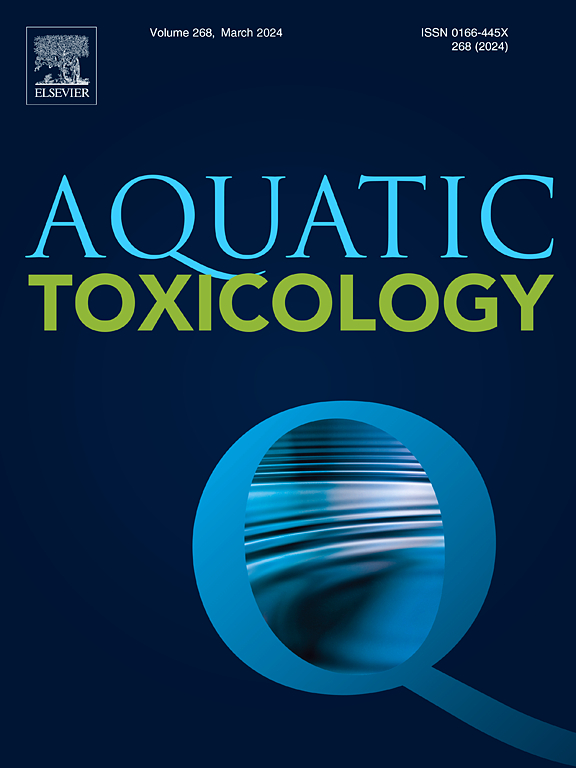Proanthocyanidins mitigate the toxic effects in loach (Misgurnus anguillicaudatus) exposed to phenanthrene via Nrf2/NF-κB signaling pathway
IF 4.1
2区 环境科学与生态学
Q1 MARINE & FRESHWATER BIOLOGY
引用次数: 0
Abstract
Phenanthrene (PHE) is a typical polycyclic aromatic hydrocarbon compound that is ubiquitous in the environment and accumulates in aquatic products, thereby posing a risk to food safety. Oligomeric proanthocyanidins (OPC) is widely distributed powerful antioxidants with potent antioxidant and anti-inflammatory properties. This study aimed to evaluate the alleviating effects of dietary OPC on oxidative stress, inflammatory suppression, and tissue damage caused by PHE exposure in loach (Misgurnus anguillicaudatus). In the study, loach was continuously exposed to 2.36 mg/L PHE for 28 days, after which they were fed a basal diet supplemented with 0, 200, 400, or 800 mg/kg OPC. The results displayed that PHE exposure resulted in significantly increased levels of liver health parameters (AST, ALT, COR, LDH, and ADA) compared to the control group (P < 0.05). The PHE-exposed fish showed the lowest levels of antioxidant enzymes (CAT, SOD, GSH, GST, GSH-Px, and GR) and the greatest levels of oxidative stress parameters (ROS and MDA). PHE exposure resulted in down-regulation of nrf2, ho-1, gsh-px, gst, and nqo-1, and up-regulation of keap-1 gene expressions in loach (P < 0.05). Moreover, PHE-induced decreased the levels of immunity indicators (CRP, MPO, C3, C4, IgM, and LYS). An up-regulation of pro-inflammatory genes (nf-κb, il-1β, il-8, il-6, il-12, and tnf-α) and a down-regulation of anti-inflammatory gene il-10 were the consequences of the PHE exposure. In addition, tissues showed histopathological alterations including vacuolization (liver), displaced nuclei (liver), atrophy (gills), glomerular congestion (kidney), and inflammatory cell infiltration (spleen) caused by PHE. Notably, dietary supplementation of OPC augmented immuno-antioxidant parameters, including their key genes, reduced oxidative stress and immunosuppression, and ameliorated tissue damage compared to fish exposed to PHE. In summary, supplementation with 400 mg/kg OPC in the diets could effectively alleviate the oxidative damage and inflammatory response induced by PHE exposure in loach through the Nrf2/NF-κB signaling pathway and enhance the defense ability against toxic substances of loach.
原花青素通过Nrf2/NF-κB信号通路减轻泥鳅(Misgurnus anguillicaudatus)暴露于菲的毒性效应。
菲(PHE)是一种典型的多环芳烃化合物,在环境中无处不在,会在水产品中积累,从而对食品安全构成威胁。寡聚原花青素(OPC)是一种广泛分布的强效抗氧化剂,具有强大的抗氧化和抗炎特性。本研究旨在评估膳食 OPC 对泥鳅(Misgurnus anguillicaudatus)暴露于 PHE 所引起的氧化应激、炎症抑制和组织损伤的缓解作用。在这项研究中,泥鳅连续暴露于 2.36 毫克/升 PHE 28 天,然后喂食添加了 0、200、400 或 800 毫克/千克 OPC 的基础膳食。结果显示,与对照组相比,暴露于 PHE 会导致肝脏健康参数(AST、ALT、COR、LDH 和 ADA)水平显著升高(P < 0.05)。暴露于 PHE 的鱼的抗氧化酶(CAT、SOD、GSH、GST、GSH-Px 和 GR)水平最低,氧化应激参数(ROS 和 MDA)水平最高。PHE 暴露导致泥鳅的 nrf2、ho-1、gsh-px、gst 和 nqo-1 基因表达下调,keap-1 基因表达上调(P < 0.05)。此外,PHE 诱导的免疫指标(CRP、MPO、C3、C4、IgM 和 LYS)水平降低。暴露于 PHE 后,促炎基因(nf-κb、il-1β、il-8、il-6、il-12 和 tnf-α)上调,而抗炎基因 il-10 下调。此外,PHE 还导致组织病理学改变,包括空泡化(肝脏)、细胞核移位(肝脏)、萎缩(鳃)、肾小球充血(肾脏)和炎症细胞浸润(脾脏)。值得注意的是,与暴露于 PHE 的鱼类相比,膳食补充 OPC 可提高免疫抗氧化参数(包括其关键基因),减少氧化应激和免疫抑制,并改善组织损伤。综上所述,在日粮中添加 400 mg/kg OPC 可通过 Nrf2/NF-κB 信号通路有效缓解泥鳅因暴露于 PHE 而引起的氧化损伤和炎症反应,并增强泥鳅对有毒物质的防御能力。
本文章由计算机程序翻译,如有差异,请以英文原文为准。
求助全文
约1分钟内获得全文
求助全文
来源期刊

Aquatic Toxicology
环境科学-毒理学
CiteScore
7.10
自引率
4.40%
发文量
250
审稿时长
56 days
期刊介绍:
Aquatic Toxicology publishes significant contributions that increase the understanding of the impact of harmful substances (including natural and synthetic chemicals) on aquatic organisms and ecosystems.
Aquatic Toxicology considers both laboratory and field studies with a focus on marine/ freshwater environments. We strive to attract high quality original scientific papers, critical reviews and expert opinion papers in the following areas: Effects of harmful substances on molecular, cellular, sub-organismal, organismal, population, community, and ecosystem level; Toxic Mechanisms; Genetic disturbances, transgenerational effects, behavioral and adaptive responses; Impacts of harmful substances on structure, function of and services provided by aquatic ecosystems; Mixture toxicity assessment; Statistical approaches to predict exposure to and hazards of contaminants
The journal also considers manuscripts in other areas, such as the development of innovative concepts, approaches, and methodologies, which promote the wider application of toxicological datasets to the protection of aquatic environments and inform ecological risk assessments and decision making by relevant authorities.
 求助内容:
求助内容: 应助结果提醒方式:
应助结果提醒方式:


